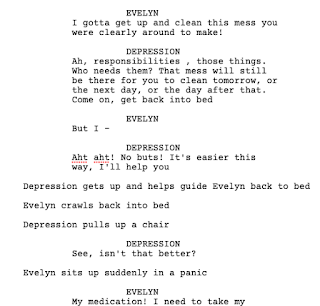My short film, Reaching Equilibrium, is about a teenage girl named Evelyn who was recently diagnosed and starting treatment for bipolar disorder. When researching representation of bipolar disorder in film, I noticed that so many productions create awful stigmas surrounding the disorder that have seeped into our mindset as a collective when we hear the term bipolar disorder. The first thought that tends to come to people’s minds when they initially hear the psychological term, is that people with the disorder are inherently violent. This is in large part due to the lack of good representation of the disorder and even more so the numerous amounts of media that give very poor representation of it.
One example in my research that stood out to me in particular was episode 22 of Law and Order: SVU’s seventh season. It’s about a young woman who upon having the court rule the rape allegations she made as false, attempted to commit suicide but in doing so murdered somebody. She was also diagnosed with bipolar disorder and refused to take her medication (yet another stereotype.) They attempted to use that as an excuse for her actions in the episode. This is a trope that many productions are guilty of falling back on, particularly within the crime drama and horror genres.
Another example I found guilty of using this trope too was Silver Linings Playbook. This film does a great job in accurately portraying not only bipolar disorder but mental health as a whole, as well as placing the topic of mental health in a genre that isn’t horror or crime drama, but something more light hearted like a rom-com. It follows the main character Pat, who returns home to his family to reintegrate back to normal life after a court ordered stay in a psychiatric facility where he is diagnosed with bipolar disorder. While this film does mostly everything right, it still used the violent stereotype. The reason Pat was sent to a psychiatric hospital by the court was because of his violence towards another teacher at his school for having an affair with his (Pat’s) wife. He also additionally gets riled up and angry very easily throughout the film where he resorts to violent behavior.
These are just two of many examples of the media misrepresenting mental health, specifically bipolar disorder. In my research I noticed two major ways many productions go wrong when it comes to representing the disorder. The most obvious being that nobody on set, actors or those behind the camera, have the disorder themselves. When you are a director who has no personal experience with the disorder and/or cast people who also have no experience with it, the production is already set up for failure. Making art about your truth and what you know is the best way to make a piece successful, and that goes for anything. The second way productions go wrong in representing bipolar disorder is that they show the character’s actions without giving the audience insight into the thoughts, emotions, and feelings that drive those character’s “abnormal” actions. This makes it incredibly easy to judge and misunderstand the character and therefore the disorder because the media makes up a significantly large part of how we see the world and the people and things in it.
I wanted to change this narrative that so often fails in representing those with bipolar disorder by changing the two said ways many productions attempting to represent the disorder fail. So I decided to personify the disorder. By that I mean I still had the main character, Evelyn, be the one struggling with the disorder but I had two other actors act as some of her symptoms as if those symptoms were people. Since the main characteristics of bipolar disorder is mood swings and experiencing episodes of mania and episodes of depression, I had one actor represent depression and the other represent mania. I did this in the hopes that my audience would understand more why people with the disorder do what they do by representing Evelyn’s thoughts and feelings as if they were people speaking directly to her. Additionally, I wanted to grow empathy within the audience towards those who struggle with more stigmatized and serious mental health disorders. We are seeing a growing concern about taking care of our mental health with the same care that we would with our physical health, but we are still only stuck on disorders like unipolar depression and anxiety disorders. We have yet to fully destigmatize mental health disorders such as bipolar disorder, schizophrenia and other psychotic disorders, borderline personality disorder and other personality disorders, dissociative identity disorder, and so on and so forth. They are too often demonized and misrepresented if they are even represented at all.
This brings me to how the elements of my production work together to create a sense of branding and how my production engages with my audience. I’ve always wanted whatever I do and whatever I create in life to help people, even if it only helps one person that means I have fulfilled my goal in some way. In a way, that sense of “branding” and engaging with my audience intertwine with one another. My goal with this project was that I help my audience in one of two ways (or both if it resonates) : One, if they are struggling with their own mental health, they can see themselves in a piece of media and know that they are not alone and two, if they don’t struggle with their own mental health and have little to no knowledge about the subject then they can learn to develop empathy towards those who do and furthermore learn what mental illness can look like outside of the stigmatizing lens the media creates of it.











